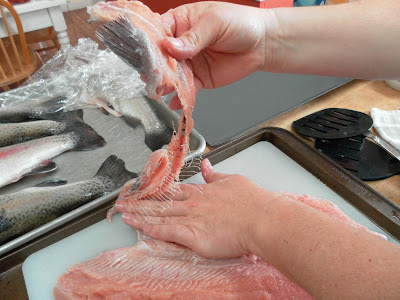How to fillet a fish, step by step:
Start with fish that have been cleaned and heads removed.
Gather your equipment. You will need: a sharp knife, a cutting board, a wide spatula, a pair of tweezers and a wide, shallow pan or electric skillet.
Heat water in pan or skillet to barely simmering, 200-225 degrees. You will see bubbles forming on the bottom of the pan and the water will be just too hot to the touch. You want to heat the fat layer between the fish and the skin, so the skin will come off easily, but you do not want to poach the fish.
Move fish to the water, supporting it with spatula. Turn the fish to heat both sides and alternately, spoon hot water over the top. The fish should not stay in the water long. It is a blanching process and only takes a minute. The skin will take on a milky look and will be slippery. The edges may begin to curl.
Begin to skin the fish by sliding your fingers between fish and skin. Working down the center (on this fish, right under the pink part of the skin) and out to the sides, peel skin off the fish.
Place knife at the base of this top fin and break off.
Next, grasp the fish in one hand and the tail fin in the other. Be gentle with the fish, as the flesh can crumble here. Break the tail fin away. You may have to use a knife to place against the bone and pull to break.
After fins are removed, hold fish in hand or lay flat on cutting board (smaller fish are easier to work with in your hand, larger on the board). Look along the top of the fish. There is a fat layer, easily seen on this pink fish; it is the grayer band along the back. Using a sharp knife, cut along each side of this layer, forming a v-shape, and feeling with the tip of the knife for the top of the rib bones of the fish.
This is another view of that cut. Cut from top to tail, stopping where the rib bones stop and inserting the knife all the way through the fish.
Like this.
This is another angle to illustrate where the knife gets inserted just below the ribs (but this photo was taken a bit later in the process—yours shouldn't look like this yet).
Determine which side of the main backbone that your knife is on. Tip knife blade toward bone, and while steadying the fish with opposite hand, cut toward tail in a see-saw motion. You have to work the knife firmly against the bone and apply pressure on the outside of the fish to get a good cut here. It will take some practice.
(This shows the first side done and the bone you are working around.) Repeat on the opposite side of the bone, turning fish over if necessary. The results should produce this:
Now you are ready to pull the main skeleton from the fish. Place one hand on the bottom fillet at tail end. Gather the bone and upper fillet in your other hand.
Pull up on bones while holding flesh down with your bottom hand. Run your fingers along the flesh as you pull the bones away, just between the rib bones and upper set of bones.
Next, using tweezers and your fingers, feel for any bones left behind and remove them. Pay attention at the top of the fillet (neck of fish) and along the upper 1/3 where the smaller set of bones came out, as these are more prone to breaking off. Take your time, run your fingers up and down that line and left over bones may stand up for you. Be gentle however, as the fish flesh can be fragile.
Rinse your fillets to remove stray bits of skin and fat. Good Work!
Notes: Jessi says to only attempt filleting fresh caught fish. If they have been frozen, the meat is just too delicate to work with. You could freeze your fillets though.
Jessi sent me home with a fish to fillet after showing me the process. This is what my first attempt looks like:
The center, somewhat tattered fillets are mine, but I did it! The fillet stayed intact for the most part and I didn't find any bones while I was eating it, so I consider that not too bad for a first round.
Cooking your fillets is simple: On a plate, combine some flour and some seasoned salt (or other seasoning of your choice) dredge fillets in flour on both sides, then fry in a little oil in a skillet, until golden brown.














































No comments:
Post a Comment